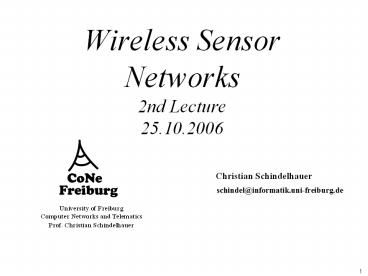Wireless Sensor Networks 2nd Lecture 25.10.2006 - PowerPoint PPT Presentation
Title:
Wireless Sensor Networks 2nd Lecture 25.10.2006
Description:
Wireless Sensor Networks 2nd Lecture 25.10.2006 Christian Schindelhauer – PowerPoint PPT presentation
Number of Views:107
Avg rating:3.0/5.0
Title: Wireless Sensor Networks 2nd Lecture 25.10.2006
1
Wireless SensorNetworks2nd Lecture25.10.2006
- Christian Schindelhauer
2
Wireless Sensor Networks
- Participants in the previous examples were
devices close to a human user, interacting with
humans - Alternative concept
- Instead of focusing interaction on humans, focus
on interacting with environment - Network is embedded in environment
- Nodes in the network are equipped with sensing
and actuation to measure/influence environment - Nodes process information and communicate it
wirelessly - ? Wireless sensor networks (WSN)
- Or Wireless sensor actuator networks (WSAN)
3
Roles of Participants in WSN
- Sources of data Measure data, report them
somewhere - Typically equip with different kinds of actual
sensors - Sinks of data Interested in receiving data from
WSN - May be part of the WSN or external entity, PDA,
gateway, - Actuators Control some device based on data,
usually also a sink
4
Structuring WSN Application Types
- Interaction patterns between sources and sinks
classify application types - Event detection Nodes locally detect events
(maybe jointly with nearby neighbors), report
these events to interested sinks - Event classification additional option
- Periodic measurement
- Function approximation Use sensor network to
approximate a function of space and/or time
(e.g., temperature map) - Edge detection Find edges (or other structures)
in such a function (e.g., where is the zero
degree border line?) - Tracking Report (or at least, know) position of
an observed intruder (pink elephant)
5
Deployment Options for WSN
- How are sensor nodes deployed in their
environment? - Dropped from aircraft ? Random deployment
- Usually uniform random distribution for nodes
over finite area is assumed - Is that a likely proposition?
- Well planned, fixed ? Regular deployment
- E.g., in preventive maintenance or similar
- Not necessarily geometric structure, but that is
often a convenient assumption - Mobile sensor nodes
- Can move to compensate for deployment
shortcomings - Can be passively moved around by some external
force (wind, water) - Can actively seek out interesting areas
6
Maintenance Options
- Feasible and/or practical to maintain sensor
nodes? - E.g., to replace batteries?
- Or unattended operation?
- Impossible but not relevant? Mission lifetime
might be very small - Energy supply?
- Limited from point of deployment?
- Some form of recharging, energy scavenging from
environment? - E.g., solar cells
7
Characteristic Requirements for WSNs
- Type of service of WSN
- Not simply moving bits like another network
- Rather provide answers (not just numbers)
- Issues like geographic scoping are natural
requirements, absent from other networks - Quality of service
- Traditional QoS metrics do not apply
- Still, service of WSN must be good Right
answers at the right time - Fault tolerance
- Be robust against node failure (running out of
energy, physical destruction, ) - Lifetime
- The network should fulfill its task as long as
possible definition depends on application - Lifetime of individual nodes relatively
unimportant - But often treated equivalently
8
Characteristic Requirements for WSNs
- Scalability
- Support large number of nodes
- Wide range of densities
- Vast or small number of nodes per unit area, very
application-dependent - Programmability
- Re-programming of nodes in the field might be
necessary, improve flexibility - Maintainability
- WSN has to adapt to changes, self-monitoring,
adapt operation - Incorporate possible additional resources, e.g.,
newly deployed nodes
9
Required Mechanisms to Meet Requirements
- Multi-hop wireless communication
- Energy-efficient operation
- Both for communication and computation, sensing,
actuating - Auto-configuration
- Manual configuration just not an option
- Collaboration in-network processing
- Nodes in the network collaborate towards a joint
goal - Pre-processing data in network (as opposed to at
the edge) can greatly improve efficiency
10
Required Mechanisms to Meet Requirements
- Data centric networking
- Focusing network design on data, not on node
identities (id-centric networking) - To improve efficiency
- Locality
- Do things locally (on node or among nearby
neighbors) as far as possible - Exploit tradeoffs
- E.g., between invested energy and accuracy
11
MANET vs. WSN
- Many commonalities Self-organization, energy
efficiency, (often) wireless multi-hop - Many differences
- Applications, equipment MANETs more powerful
(read expensive) equipment assumed, often human
in the loop-type applications, higher data
rates, more resources - Application-specific WSNs depend much stronger
on application specifics MANETs comparably
uniform - Environment interaction core of WSN, absent in
MANET - Scale WSN might be much larger (although
contestable) - Energy WSN tighter requirements, maintenance
issues - Dependability/QoS in WSN, individual node may be
dispensable (network matters), QoS different
because of different applications - Data centric vs. id-centric networking
- Mobility different mobility patterns like (in
WSN, sinks might be mobile, usual nodes static)
12
Enabling Technologies for WSN
- Cost reduction
- For wireless communication, simple
microcontroller, sensing, batteries - Miniaturization
- Some applications demand small size
- Smart dust as vision
- Energy harvesting
- Recharge batteries from ambient energy (light,
vibration, )
13
Conclusion
- MANETs and WSNs are challenging and promising
system concepts - Many similarities, many differences
- Both require new types of architectures
protocols compared to traditional
wired/wireless networks - In particular, application-specificness is a new
issue
14
Thank you(and thanks go also to Holger Karl for
providing slides)
Wireless Sensor Networks Christian
Schindelhauer 2nd Lecture25.10.2006































